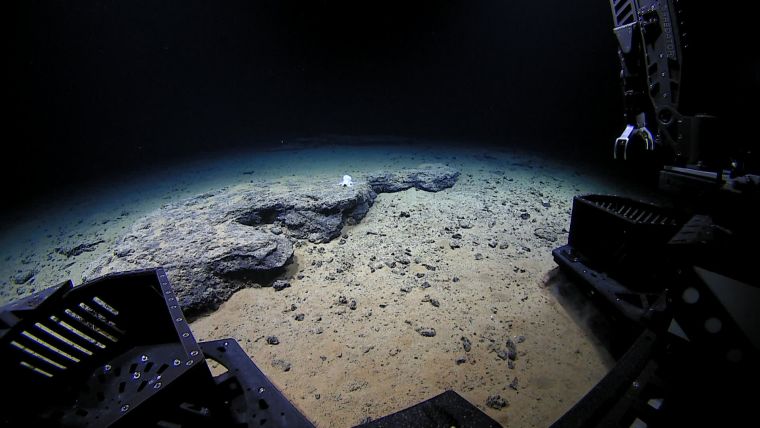Manganese Nodules as Breeding Ground for Deep-sea Octopuses
Manganese nodules on the seabed of the Pacific Ocean are an important breeding ground for deep-sea octopuses. As reported by a German-American team of biologists in the latest issue of the journal 'Current Biology', the octopuses deposit their eggs onto sponges that only grow locally on manganese nodules. The researchers had observed the previously unknown octopus species during diving expeditions in the Pacific at depths of more than 4,000 metres – new record depths for these octopuses.
Their specific dependence on manganese nodules for brooding eggs shows that the industrial extraction of resources in the deep sea must be preceded by thorough investigations into the ecological consequences of such actions.
Casper, the Deep-sea Octopus
Do you know Casper? In February this year, the deep-sea octopus (Octopoda, suborder: Incirrina) became a social media star within only a few days. The US diving robot Deep Discovery detected the approximately ten centimetre marine creature off the Hawaiian Necker Island at a depth of 4,290 metres, taking close-up video and publishing the footage online. The web community named the virtually transparent octopus Casper, after the famous cartoon ghost. The video was watched hundreds of thousands of times – but only now are researchers in the journal Current Biology revealing the extensive knowledge about life in the deep sea and the ecological significance of the manganese nodules that they have managed to tease out of the observation of this Hawaiian Casper octopus, and 28 additional observations of similar octopuses made elsewhere in the Pacific.
The appearance of the Hawaiian Casper octopus in front of the camera at a depth of 4,290 metres is the greatest depth at which such finless octopuses have to date been observed. Six months earlier, researchers of the Alfred Wegener Institute, the GEOMAR, the Max Planck Institute for Marine Microbiology, and the Centre for Marine Environmental Sciences (MARUM) had filmed and photographed more specimens of this or similar hitherto unknown octopus species at a depth of 4,120 to 4,197 metres in the Peru Basin in the south-eastern Pacific Ocean. The photos and films of these octopuses were taken with diving robot ROV KIEL 6000 and a towed camera system (AWI-OFOS).
Sponges on Manganese Nodules
Until they made these observations, the researchers had assumed that these octopuses only occur at depths of up to 2,600 metres. Two of the octopuses were seen by the camera system to be guarding their eggs. At a depth of 4,000 metres, these animals had deposited their eggs onto the stems of dead sponges, which in turn had grown on manganese nodules. The nodules served as the only anchoring point for the sponges on the otherwise very muddy seafloor. This means that without the manganese nodules the sponges would not have been able to live in this spot, and without sponges the octopuses would not have found a place to lay their eggs.
What's more: Even octopuses not actually brooding seek the proximity of manganese nodules and rocky protrusions. The video footage indicates that the animals have cleaned the seabed around the nodules. It probably looks like that because the animals have been filmed using their arms to dig into the sediment around the nodules probably in search for food," says co-author Henk-Jan Hoving of the GEOMAR Helmholtz Centre for Ocean Research.
Manganese Nodules Needed
The so-called DISCOL experiment from the late 1980s shows that many deep-sea animals need manganese nodules in their habitat. At the time, also in the Peru Basin, German researchers had removed manganese nodules by ploughing them into the seabed. In subsequent years, they observed the consequences of this human intervention on the deep-sea community. 26 years later, researchers of the expedition with RV Sonne returned to the place where the DISCOL experiment was carried out. Their conclusion: "The removal of the manganese nodules at that time caused the community of animals that are attached to the seafloor, which also includes sponges, to almost fully collapse. Even 26 years later many animal populations have not yet recovered," explain the authors in the new study.
The observation data presented as part of the current study was collected during several expeditions. The shots from the Peru Basin were taken in the autumn 2015 during a research cruise by the German research vessel Sonne. The dives of the Deep Discovery robot near the Hawaiian Necker Island were part of an expedition of the US research vessel Okeanos Explorer and took place in February 2016. Further observations were made during a tour of the Kilo Moana research vessel in 2011.
The research was funded by the EU project "Managing Impacts of Deep-seA reSource exploitation (MIDAS)". The work on board the Sonne research vessel was made possible by the German Federal Ministry of Education and Research as part of the "Mining Impact of the Joint Programming Initiative Healthy and Productive Seas and Oceans (JPIO)" project.














